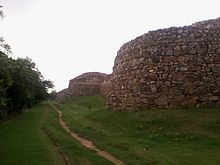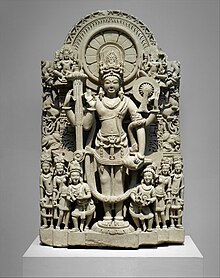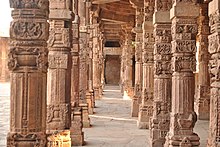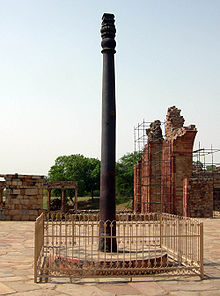Tomaras of Delhi
Tomara dynasty | |||||||||
|---|---|---|---|---|---|---|---|---|---|
| c. 736 CE–c. 1152 CE | |||||||||
Location of the Tomaras and neighbouring South Asian polities in 1000 CE.[1] | |||||||||
| Status |
| ||||||||
| Capital | |||||||||
| Common languages | |||||||||
| Religion | Hinduism | ||||||||
| Government | Monarchy | ||||||||
| History | |||||||||
• Established | c. 736 CE | ||||||||
• Disestablished | c. 1152 CE | ||||||||
| |||||||||
| Today part of | India | ||||||||

The Tomaras of Delhi (also called Tomar dynasty in modern vernaculars due to schwa deletion) ruled parts of present-day Delhi and Haryana in India during 8th-12th century. Their rule over this region is attested to by multiple inscriptions and coins. In addition, much of the information about them comes from medieval bardic legends. They belonged to the Tomar clan of the Rajputs.[2][3]
They were displaced by the Chahamanas of Shakambhari in the 12th century, who took over their capital in Delhi, but who were themselves soon displaced by the Ghurid ruler Muhammad of Ghor in 1192 CE.[4]
Territory
The Tomara territory included parts of the present-day Delhi and Haryana. A 13th century inscription states that the Tomaras ruled the Hariyanaka (Haryana) country before the Chahamanas and the Shakas (Turks in this context). A 14th century inscription states that they built Dhillika (modern day Delhi) a city in the Haryana region. Around that city is a fortified wall called Lal Kot built by Anangpal Tomar. It is also known that the Tomara kingdom stretched to Hansi and areas at Thanesar.[5] The Tomara's rule was followed by that of the Chahamanas and the mlechchha Sahavadina (Shihab ad-Din).[6]
History
The Tomaras are known from some inscriptions and coins. However, much of the information about the dynasty comes from medieval bardic legends, which are not historically reliable. Because of this, the reconstruction of Tomara history is difficult.[6]
As feudatories
The earliest extant historical reference to the Tomaras occurs in the Pehowa inscription issued during the reign of the Pratihara king Mahendrapala I (r. c. 885-910 CE).[7] This undated inscription states that Jaula of the Tomara family became prosperous by serving an unnamed king. His descendants included Vajrata, Jajjuka, and Gogga. The inscription suggests that Gogga was a vassal of Mahendrapala I. It records the construction of three Vishnu temples by Gogga and his step-brothers Purna-raja and Deva-raja. The temples were located at Prithudaka (IAST: Pṛthūdaka; Pehowa), on the banks of the Sarasvati river.[8]
No information is available about the immediate successors of Gogga.[9] The Pehowa inscription suggests that this particular Tomara family was settled around the Karnal area. However, F. Kielhorn suggested that this Tomara family actually resided in Delhi: they may have visited Pehowa on pilgrimage, and built a temple there.[10]
As sovereigns
As the Pratihara power declined, the Tomaras established a sovereign principality around Delhi by the 10th century.[11] According to the bardic tradition, the king Anangapal Tuar (that is Anangapala II Tomara; not to be confused with the founder of the Tomara dynasty Anangpal I) founded Delhi in 1052 CE.[6] A 1526 CE source names the successors of Anangapala as Tejapala, Madanapala, Kritapala, Lakhanapala and Prithvipala. The Dravya-Pariksha (1318 CE) of Thakkura Pheru mentions the coins of Madanapala, Prithvipala and another ruler, Chahadapala.[12]

Soon after gaining independence, the Tomaras became involved in conflicts with their neighbours, the Chahamanas of Shakambhari and later on the Gahadavala dynasty.[13] According to a 973 CE inscription of the Chahamana king Vigraharaja II, his ancestor Chandana (c. 900 CE) killed the Tomara chief Rudrena (or Rudra) in a battle.[11] The Harsha stone inscription states that Chandana's descendant Simharaja (c. 944-971 CE) defeated a Tomara leader called Lavana or Salavana. Historian R. B. Singh identifies the defeated ruler as Tejapala.[14] Another fragmentary Chahamana prashasti (eulogistic inscription), now at the Ajmer museum, mentions that the Chahamana king Arnoraja (c. 1135-1150 CE) invaded the Haritanaka country. This country is identified with the Tomara territory. According to the inscription, Arnoraja's army rendered the waters of the Kalindi river (Yamuna) muddy and the women of Hartinaka tearful, but Arnoraja's victory over the Tomaras was not decisive and as his son Vigraharaja IV had to fight the Tomaras. This may have been because Anoraja was unsuccessful of getting through the fort Lal Kot which had been built by the Tomara rulers.[15][16]

The writings of the medieval Muslim historians suggest that a king named Mahipala was ruling Delhi in the 11th century. Although these medieval historians do not mention the dynasty of this king, he is identified as a Tomara ruler by some modern historians. Some coins featuring crude depictions of a horseman and a bull, and bearing the name "Mahipala", have been attributed to this king. These coins are similar to those of Mawdud of Ghazni (r. 1041-50 CE), confirming that Mahipala must have ruled in the 11th century. The horseman-and-bull were a characteristic of the Kabul Shahi coinage; Mawdud probably adopted this style after capturing the Shahi territories. Mahipala probably imitated the same style after capturing Asigarh Fort in Hansi and Thaneshvara regions from Mawdud. Some fragmentary Tomara inscriptions have been discovered from Mahipalpur near Delhi. Historian Y. D. Sharma theorizes that Mahipala established a new capital at Mahipalapura (now Mahipialpur).[5]



Three Tomara kings seem to have shared the name "Anangapala" (IAST: Anaṅgapāla). One of these is said to have established the Lal Kot citadel in the Mehrauli area. The construction of the Anang Tal tank and the Anangpur Dam is also attributed to him.[citation needed] His coins also feature the horseman-and-bull figure, and bear the title "Shri Samanta-deva". These coins are very similar to those of the Shakambhari Chahamana kings Someshvara and Prithviraja III, indicating that Anangapala was a contemporary of these 12th century kings.[19] One of the several inscriptions on the Iron Pillar of Delhi mentions Anangapala. A medieval legend mentioned in a copy of Prithviraj Raso mentions a legend about the pillar: a Brahmin once told Anangapala (alias Bilan Deo) that the base of the pillar rested on the head of the Vasuki serpent, and that his rule would last as long as the pillar stood upright. Out of curiosity, Anangapala dug out the pillar, only to find it smeared with the blood of Vasuki. Realizing his mistake, the king ordered it to be re-instated, but it remained loose ("dhili"). Because of this, the area came to be known as "Dhilli" (modern Delhi). This legend is obviously a myth.[20]
Decline
The bardic legends state that the last Tomar Rajput king, Anangpal Tomar (also known as Anangapala), handed over the throne of Delhi to his son-in-law Prithviraj Chauhan (Prithviraja III of the Chahamana dynasty of Shakambhari; r. c. 1179-1192 CE). However, this claim is not correct: the historical evidence shows that Prithviraj inherited Delhi from his father Someshvara.[6] According to the Bijolia inscription of Someshvara, his brother Vigraharaja IV had captured Dhillika (Delhi) and Ashika (Hansi). He probably defeated the Tomara ruler Anangapala III.[10]
See also
References
- ^ Schwartzberg, Joseph E. (1978). A Historical atlas of South Asia. Chicago: University of Chicago Press. pp. 31, 32. ISBN 0226742210.
- ^ Upinder Singh (2004). The Discovery of Ancient India: Early Archaeologists and the Beginnings of Archaeology. Permanent Black. p. 73. ISBN 978-81-7824-088-6.
Discussion of the histories of various Rajput clans, such as the Chauhans, Kachhvahas, Chandelas, Pratiharas and Tomaras on the basis of a wide range of sources-literary, epigraphic, numismatic, bardic accounts and local traditions
- ^ Kulke, Hermann; Rothermund, Dietmar (2004). A History of India. Psychology Press. p. 117. ISBN 978-0-415-32919-4.
When Gurjara Pratiharas power declined after the sacking of Kannauj by the Rashtrakutas in the early tenth century many Rajput princes declared their independence and founded their own kingdoms, some of which grew to importance in the subsequent two centuries. The better known among those dynasties were the Chaulukyas or Solankis of Gujarat and Kathiawar, the Chahamanas (i.e. Chauhans) of eastern Rajasthan (Ajmer and Jodhpur) and the Tomaras who had founded Delhi (Dhillika) in 736 but had been displaced by the Chauhans in the twelfth century.
- ^ Ray, Himanshu Prabha (5 September 2018). Decolonising Heritage in South Asia: The Global, the National and the Transnational. Taylor & Francis. p. 142. ISBN 978-0-429-80285-0.
- ^ a b P. C. Roy 1980, pp. 93–94.
- ^ a b c d D. C. Ganguly 1981, p. 704.
- ^ Sailendra Nath Sen 1999, p. 339.
- ^ Dilip Kumar Ganguly 1984, pp. 116–117.
- ^ D. C. Ganguly 1981, p. 705.
- ^ a b Dilip Kumar Ganguly 1984, p. 117.
- ^ a b Swati Datta 1989, p. 102.
- ^ Buddha Prakash 1965, p. 182.
- ^ Roma Niyogi 1959, p. 51-52.
- ^ R. B. Singh 1964, pp. 100–102.
- ^ H. A. Phadke 1990, p. 87.
- ^ Dasharatha Sharma 1959, p. 45.
- ^ Ray, Himanshu Prabha (5 September 2018). Decolonising Heritage in South Asia: The Global, the National and the Transnational. Taylor & Francis. p. 142. ISBN 978-0-429-80285-0.
- ^ Arnold Silcock; Maxwell Ayrton (2003). Wrought iron and its decorative use: with 241 illustrations (reprint ed.). Mineola, N.Y: Dover. p. 4. ISBN 0-486-42326-3.
- ^ P. C. Roy 1980, p. 95.
- ^ Upinder Singh 2008, p. 570.
Bibliography
- Buddha Prakash (1965). Aspects of Indian History and Civilization. Shiva Lal Agarwala. ISBN 9780842616812. OCLC 6388337.
- D. C. Ganguly (1981). R. S. Sharma (ed.). A Comprehensive History of India (A. D. 300-985). Vol. 3, Part 1. Indian History Congress / Orient Longmans.
- Dilip Kumar Ganguly (1984). History and Historians in Ancient India. Abhinav. p. 117. ISBN 978-0-391-03250-7.
- H. A. Phadke (1990). Haryana, Ancient and Medieval. Harman. ISBN 978-81-85151-34-2.
- Jagbir Singh (2002). The Jat Rulers of Upper Doab: Three Centuries of Aligarh Jat Nobility. Aavishkar. ISBN 9788179100165.
- P. C. Roy (1980). The Coinage of Northern India. Abhinav. ISBN 9788170171225.
- R. B. Singh (1964). History of the Chāhamānas. N. Kishore. OCLC 11038728.
- Sailendra Nath Sen (1999). Ancient Indian History and Civilization. New Age. ISBN 9788122411980.
- Swati Datta (1989). Migrant Brāhmaṇas in Northern India. Motilal Banarsidass. ISBN 978-81-208-0067-0.
- Dasharatha Sharma (1959). Early Chauhān Dynasties. S. Chand / Motilal Banarsidass. ISBN 9780842606189.
- Roma Niyogi (1959). The History of the Gāhaḍavāla Dynasty. Oriental. OCLC 5386449.
- Upinder Singh (2008). A History of Ancient and Early Medieval India: From the Stone Age to the 12th Century. Pearson Education India. ISBN 978-81-317-1677-9.

